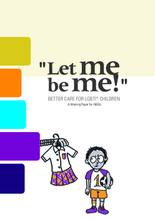Dreilinden produced this working paper to improve practice in the area of LGBTI* children in care. This paper has texts in a variety of formats from around the world and contains three sections that cover research and tools; interviews; and practice examples.
In the article, “LGBTI Rights are Children’s Rights”, Eva Maria Hilgarth discusses how LGBTI rights apply to children. She looks at the United Nations Convention on the Rights of the Child and Kristen Sandberg’s article therein and emphasizes Sandberg’s dialogue with the CRC and notes how it strengthens the position of LGBTI youth and substantiates them by means of statements from the Committee. Hilgarth also discusses protection as it pertains to LGBTI children and states CRC Article 2 covers protection of rights without discrimination for people of “other status” and that the Committee has documented “other status” to apply to LGBTI children.
Sarah Blakemore analyzes the capacity of organisations worldwide to safeguard LGBTI Children in her article “Analysing Institutional Readiness.” Blakemore reviews Keeping Children Safe, a global child safeguarding movement that works to promote international child safeguarding standards. These standards include policies that promote the well-being of children; commitments to keep children safe; procedures that implement a systematic process of planning and implementing child safeguarding measures; and measures for monitoring and accountability.
This working paper includes a second article from Hilgarth entitled, “Workshop Results: 8th Conference Rainbow Philanthropy”. This article discusses 8th Conference Rainbow Philanthropy results. In the conference workshops, all participants came up with ways to address different aspects of the topic. Workshops were: 1) LGBTI Children from a Family Perspective; 2) Institutional Readiness; 3) Awareness Raising; 4) Next Steps
Amani Njogu in the article, “Voices of LGBT Youth: Being LGBT in Alternative” provides accounts from interviewees who grew up in African alternative care organisations. The interviews include accounts from an openly gay young lesbian, a closeted gay man, closeted lesbian woman, a heterosexual transgender man.
Nguyen Van Hue provides an article entitled “A Loving Boat that Carries LGBT Youth,” which includes an interview with Save the Children in Vietnam about experiences and findings on workshops on LGBT youth, and Hue includes another article entitled “LGBT Street Youth in Vietnam,” which discusses the fulfillment the rights and protection of children.
The working paper closes with an article from Karin Demuth entitled “We Still Need to Learn,” which discusses the experiences around LGBTI children and staff in Argentina and Tunisia.
A note regarding the “I” (for “intersex”) in the LGBTI* acronym: This paper looks at a new field of work. Yes, intersex issues differ greatly from sexual orientation and gender identity issues. Key terms here are sex characteristics and bodily integrity - not sexual orientation, not even necessarily gender identity. However, many of the people who have worked on this paper feel strongly that intersex issues should be part of the conversation from the start. In cases where we include the “I”, even without being able to demonstrate specific intersex expertise, it is with this intent.

